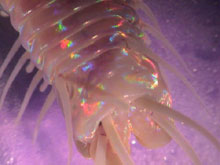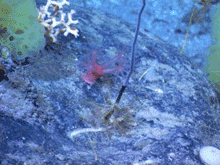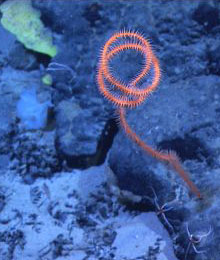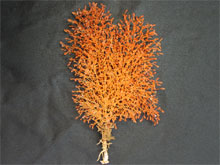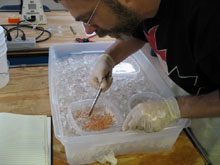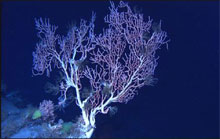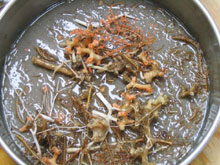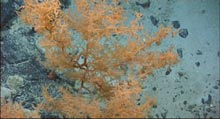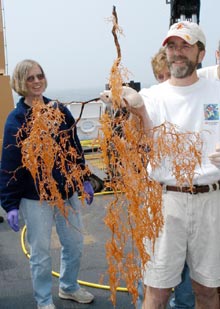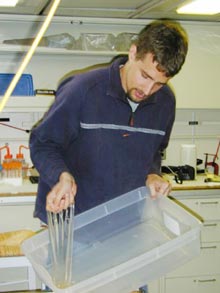A microscopic image of a large (approximately 4-in long) Eunice norvegica worm found living within "mucous tubes" woven through Lophelia coral. The iridescence is from light refraction on the cuticle secreted by the worm. Click image for larger view.
Links in Nature's Chain
May 16, 2004
Mary Grady
Adjunct Earth Science Instructor Northeastern University
Diana Payne
Biologist and Education Coordinator
Connecticut Sea Grant
The naturalists of yore esteemed the ocean to be a treasury of wonders . . . The naturalists of our own time hold equal faith in the wonders of the sea, but seek therein rather for the links of nature's chain than for apparent exceptions.
—E. Forbes, 1859
View the slide show of some of the first images taken on Manning Seamount. ![]() Click image to view a slide show.
Click image to view a slide show.
[A Readers Note: Beginning today, live video from dives will be fed to the Internet at www.explorethesea.com ![]() , from 9 am to 9 pm ET, daily. Monday through Friday at 1 pm (except Thursday at 1:30 pm) a 45-minute live Webcast from the control van will feature educational programming. The live content is free and open to anyone, but only teachers who have attended pre-cruise workshops will have a password to access the live chat feature.]
, from 9 am to 9 pm ET, daily. Monday through Friday at 1 pm (except Thursday at 1:30 pm) a 45-minute live Webcast from the control van will feature educational programming. The live content is free and open to anyone, but only teachers who have attended pre-cruise workshops will have a password to access the live chat feature.]
![]() View a second slide show of images taken May 16.
View a second slide show of images taken May 16.
Completing what the science crew is calling the most spectacular dive yet, Hercules stayed on the bottom all night. Dr. Les Watling said the dive "was just amazing." Every dive site seems to have a different dominant fauna and reveals unusual members of the benthic (bottom-dwelling) community. "We've done eight or nine dives on Manning Seamount now, and we're still going to places we haven't been to before," Watling said. "We're surprised every time by what we find here. We can't predict yet what we'll see when we explore a new site. The communities are far more diverse than anyone would have guessed."
The scientists spent this morning crowded in the lab, processing and examining their samples. Susan Mills had some interesting creatures under her microscope. She projected their images on to a video screen, where everyone could speculate on what they were. "What a bizarre head that one has," Dr. Watling said, looking at a specimen.
Dr. Scott France was excited about a long, whip-like black coral he collected. "It wasn't on our target list," he said, but when he saw it, he made a special request to collect it. After taking that specimen, the team was surprised to find that black whip corals were fairly common in the area. They were also excited by some unusual geological features, linear volcanic-domed structures, which supported abundant growth and a wide variety of species.
One of a series of odd-shaped geological features observed on Manning Seamount. Click image for larger view.
We found certain corals in abundance here that we did not find on other seamounts. "The local abundance could be an indicator of local recruitment," said Dr. Jon Moore. Also, certain species that were found last year have not been seen yet on this year's dives, Dr. Watling said, which suggests that they might be more rare than he expected.
Hercules also collected a large bamboo coral that filled up a five-gallon bucket all by itself. "When we saw this on the video, it looked very unusual, as if the polyps were retracted," France said. "Then we took it out of the bio box, and it just looked normal. So we're kind of stymied.” As an alternative explanation to polyps being retracted, Jon suggested that maybe the connecting tissue was "inflated" on the sea floor, and when it brought to the surface it "deflated." The scientists will have to go back and study the video to figure out what might really be going on.
Student Katie Olds investigated the sludge collected from the bottom of the bio box. "There are all kinds of polyps just mooshed together here," she said, "and some worms that sank to the bottom of the box—and all kinds of things." Samples from such depths are so rare and precious to the scientists that nothing is considered insignificant. It takes the entire team working at top speed for about five hours to process just 10 or 12 specimens brought up from each dive. "We're getting a ton of data," Dr. Watling said. "Plus, we can get a massive amount of science just from studying the imagery. The close-up macro shots in high definition provide us with a huge amount of taxonomic information."
Hercules and Argus are proving to be hardworking and reliable tools for doing important science. With the help of a persistent Bermuda high, which keeps the Atlantic seas calm and the winds gentle, the sheer volume of work that's been done already is impressive—and we have another week to go. Today, at the science meeting, we discussed next week's dive schedule. Since weather can't be predicted, the plans need to be somewhat ad hoc from day to day.
Nothing collected from the deep-sea bottom is insignificant. Even these scraps from the bio box will be carefully examined. Click image for larger view.
The science team wonders whether it would be better to do two short dives per day, rather than one long one, because of the uncertainty over how long the samples can survive in the bio box. "Some of the specimens have been in the box for up to 12 hours by the time they're processed," Dr. Watling said. "Flushing the box with water every hour or so while they're on the bottom seems to help. But the tissue on one of the corals had already started to rot by the time we brought it on board, so that's a concern."
The question arose whether it was the change in pressure that was harming the specimens as they came to the surface. "We've found that animals that live at depths up to 2,500 meters are not greatly affected by the pressure changes when we bring them up," Dr. Watling said. "But they are not tolerant of the temperature change. As long as you keep them cold, they're fine, and they'll survive in the lab for a long time." Since these species have evolved in an environment where temperatures vary little, they may not have much ability to withstand temperature changes. Species that live at 4,000 m or more have evolved a different enzyme structure in their proteins, Dr. Watling said, and they will break down when brought up to sea level pressures.
As soon as the ROVs were on deck this morning, the crew of the Ronald H. Brown set a course for our next stop, Kelvin Seamount. The science team spent the day in the lab processing their samples, while the ROV crew got some welcome rest and time to tweak their equipment. Hercules' manipulator arm has had some intermittent control problems, so the engineers went to work on that. Upon arrival at Kelvin later this evening, the deepest dive of this trip will begin. This will be the deepest ever for Hercules—down to 4,000 m.
Slimy Corals!
Kari Heinonen
Graduate Student
University of Connecticut
Mike McKee
Research Assistant
National Undersea Research Center
University of Connecticut
On this research cruise and on previous cruises to the canyons and seamounts of the western North Atlantic, scientists have collected gorgonians, such as the bamboo corals (Lepidisis spp.), bubblegum corals (Paragorgia spp.), sea corn (Primnoa residaeformis), and the antipatharian bushy black coral. As we collect these colonial organisms from the deep ocean, we gain a better understanding of their form and function. These gorgonians and
A bushy black coral in its natural environment. This photo was taken at Manning Seamount. Click image for larger view.
antipatharians are corals which live attached to hard substrates, such as basalt and silt-stone outcrops. They can grow more than six ft into the water column. Although they look like plants, they are actually an interconnected colony of small, sedentary animals. Each polyp extends into the water column to feed on suspended food particles being transported by currents. Further inspection of these collections has revealed that the surface of the corals is covered in mucus.
Mucus plays a functional role for many animals. Anyone who suffers from springtime allergies has experienced the role of mucus in the nasal cavity as a protectant from environmental variables. Corals in shallow reef environments produce mucus for similar protective roles. Mucous sheets prevent other organisms and particulate matter from settling on and smothering the corals, keeping their polyps clean for feeding. Mucous sheets also shade corals from harmful ultraviolet (UV) radiation, similar to the protection that sunblock provides us.
Susan Mills and Scott France, who holds a bushy black coral covered in mucus. This specimen was collected from Bear seamount. Click image for larger view.
Graduate student Mercer Brugler pulls at the highly viscous mucus collected from a bushy black coral. Click image for larger view.
We don't yet know why deep-water corals produce mucus. Unlike many antipatharians, the bushy black coral’s polyps cannot retract into its skeleton. They are constantly exposed to the surrounding water, settling organisms and particulate matter, and potential predators. It seems likely that bushy black corals, along with other deep-water corals, secrete mucus as a protective barrier to the external environment. Deep-water corals may also produce mucus to aid in feeding by trapping suspended food particles from the water column and providing a constant food supply for the polyps.
Sign up for the Ocean Explorer E-mail Update List.






















